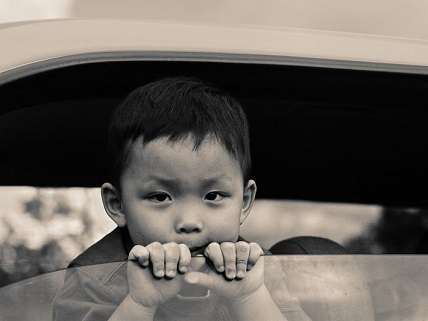Affirmative Action = Discrimination Against Asians, NYC Schools Edition
It's very difficult for low-income 13-year-olds to cobble together appealing resumes.


New York City politicians—including Mayor Bill de Blasio—want to change the admissions system for the city's nine highly-selective premiere public high schools, including nationally-renowned Stuyvesant High School. The schools currently use a single exam, the Specialized High Schools Admissions Test, to determine admittance. Less than three percent of applicants are admitted to Stuyvesant.
The problem, in the eyes of some, is that black and Latino students are increasingly underrepresented at the elite schools. So are white students. When a test score is the only criteria, it seems that Asian Americans are more likely than other racial groups to gain admission to Stuyvesant.
Is that a problem? A coalition that includes de Blasio and teachers unions says that it is, according to Bloomberg:
"I do not believe a single test should be determinative, particularly for something that is as life-changing for so many young people," de Blasio, who would need to persuade the state Legislature to amend the law, said last week. "We have to determine what combination of measures will be fair."
The mayor would like the schools to consider other factors—such as grades and extracurricular activities—that would theoretically give non-Asians a better chance.
Writing for The New York Post, Dennis Saffran—an attorney and former GOP city council candidate—explains why that's not such a great idea. It's very difficult for low-income 13-year-olds to cobble together appealing resumes, he writes. In fact, moving away from an objective test might further decrease the enrollment of poor black and Latino students, while also hurting Asian enrollment, since kids with wealthy parents are the ones best equipped to build portfolios of volunteer work and extracurricular activities:
A Chinese student like Ting Shi who has to help out in his parents' laundromat is not going on "service" trips to Nicaragua with the children in de Blasio's affluent Park Slope neighborhood. The LDF's suggested admissions criteria — student portfolios, leadership skills and community service — are all subject to privileged parents' ability to buy their children the indicia of impressiveness.
Ironically, eliminating the SHSAT would magnify the role of what progressives call "unconscious bias" — the idea that we have a preference for those who look like us and share our backgrounds. Subjective evaluation measures like interviews and portfolio reviews are much more susceptible to such bias than is an objective examination.
Sure, the decision makers will do their best to admit a few more black and Latino kids (especially those from the same upper-middle-class backgrounds), but the primary beneficiaries will be affluent white students who didn't study hard enough to perform really well on the test but seem more "well-rounded" than those who did. As always, the losers in this top-bottom squeeze will be the lower middle and working classes. Among the applicant pool for the specialized high schools, that means Asians.
As Saffran's critique makes clear, attempting to engineer admissions to produce some politically desirable racial mixture is both dubious and difficult. On the latter point, whose to say that a reformed admissions system won't cause further problems? It could exacerbate the very discrepancies it's attempting to resolve. It could also incidentally result in the admission of unqualified students—something administrators expect to happen if the test is no longer the focus—harming the rigor of the schools.
While I can understand the desire to assist groups that aren't making the cut for selective public schools, it doesn't seem fair—or morally justifiable—to stack the game against Asians seeking admittance merely because other Asians have fared well.
Of course, this is exactly what universities practicing affirmative action have done for years, using ethnicity-based admission systems that grade Asian applicants on a much higher curve. Should students be judged on their own merits or against the expected accomplishments of other people who happen to look like them?


Show Comments (61)